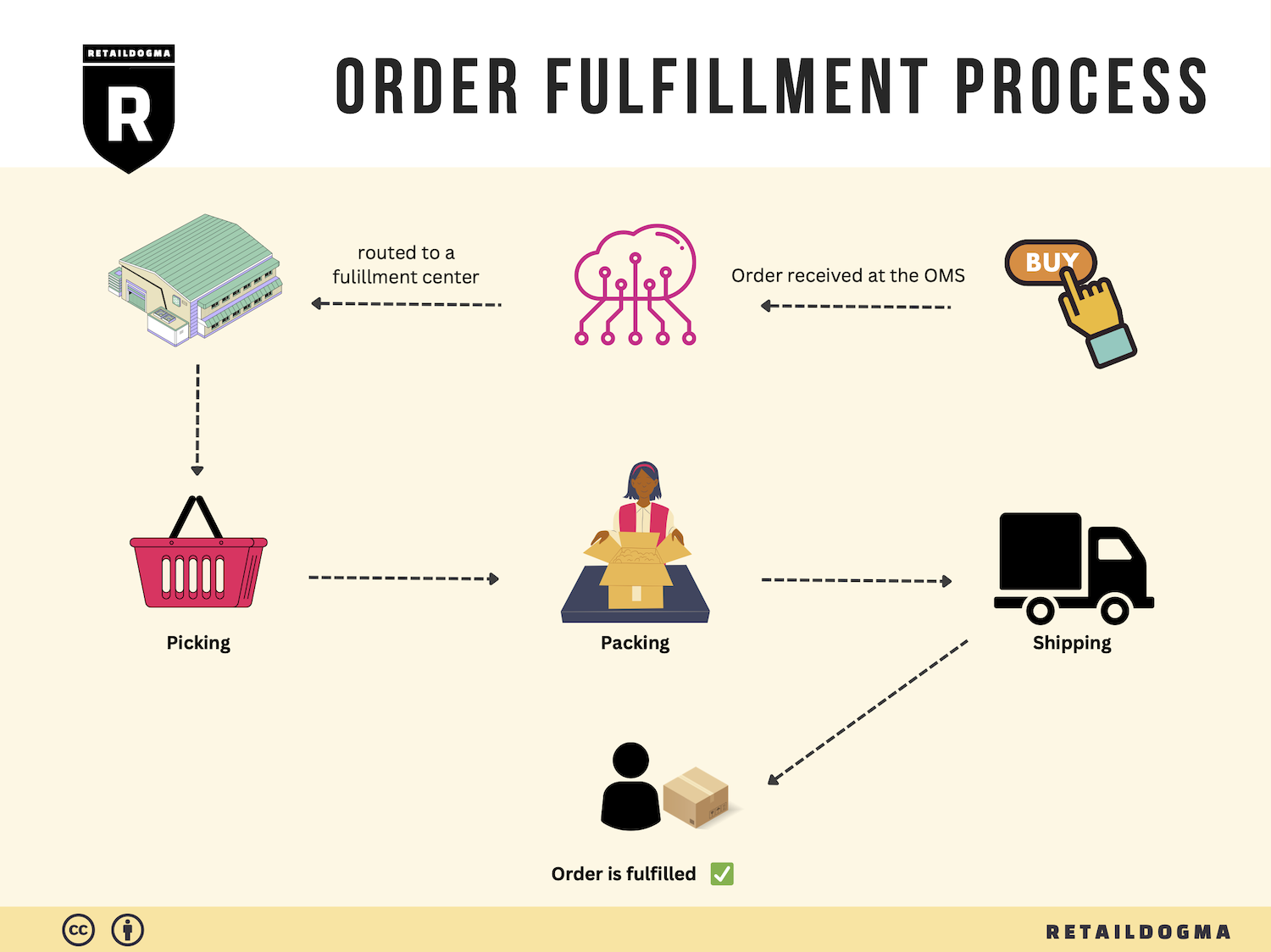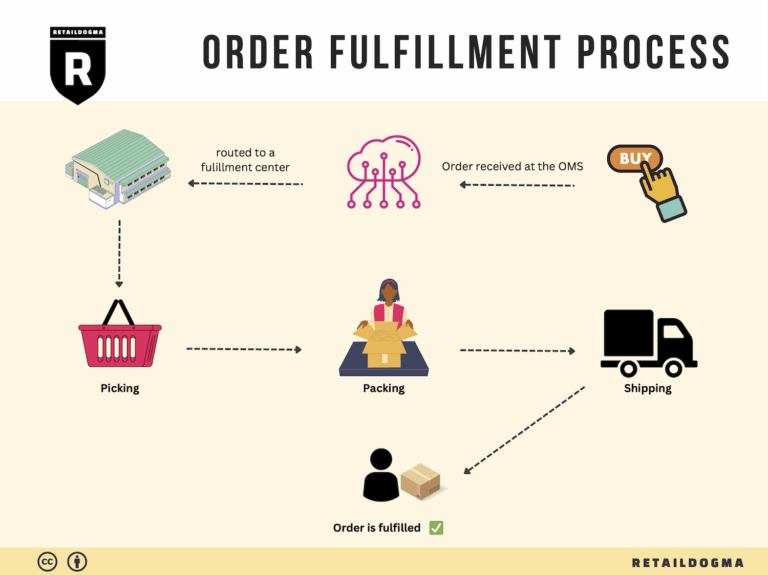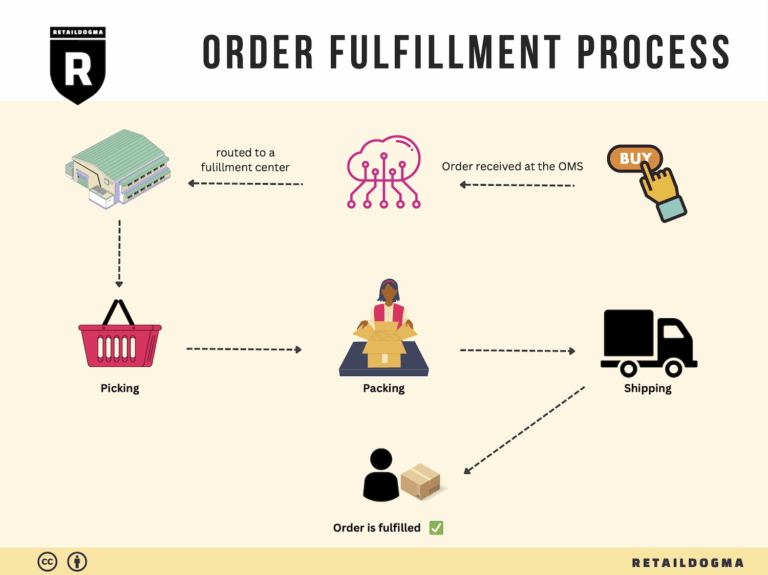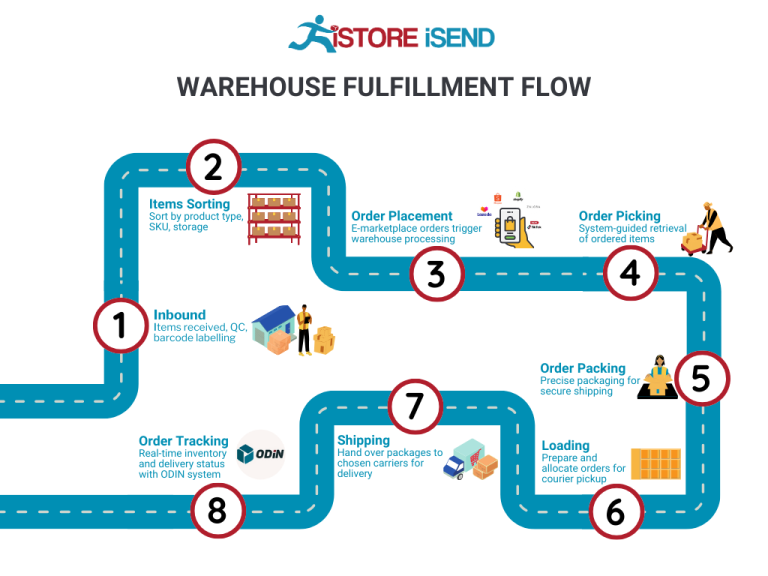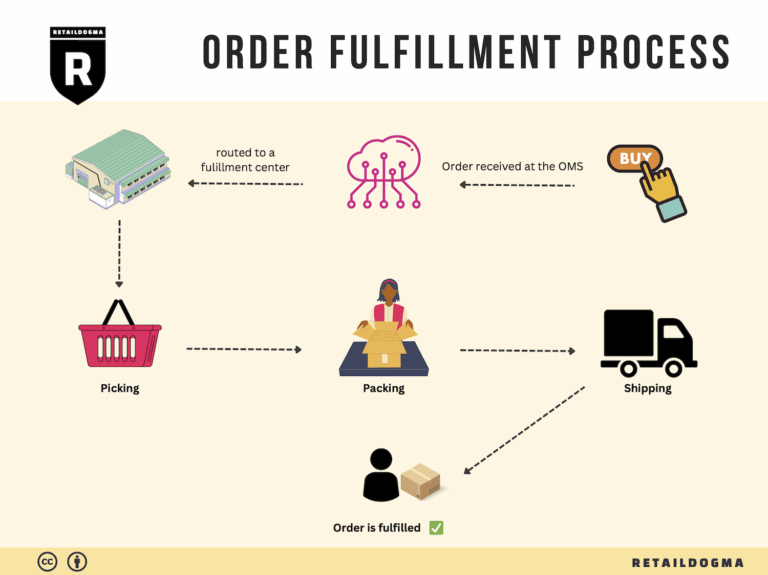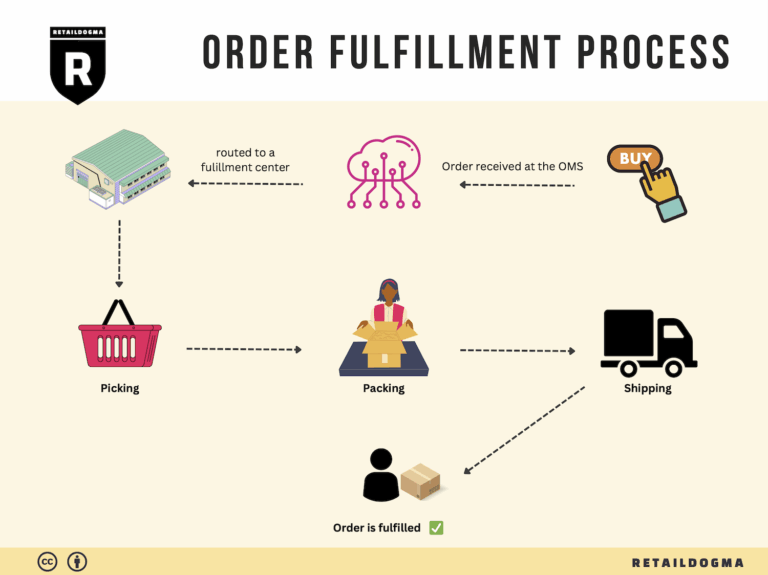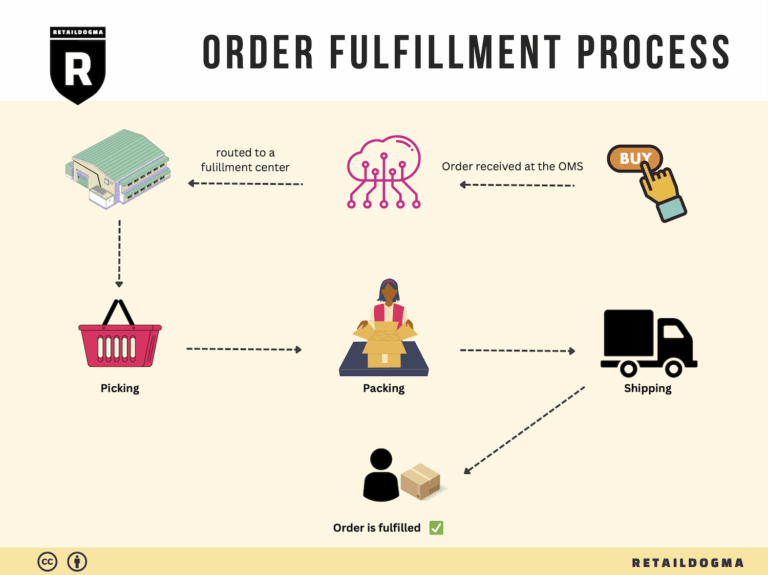What Is A Fulfillment Center? A Complete Guide (2025)
What is E-commerce Fulfillment? An Introduction for Growing Businesses
Understanding E-commerce Fulfillment
As an e-commerce business owner, you may find yourself grappling with the daunting task of packing and shipping orders as your sales begin to grow. This often leads to stress and confusion, taking valuable time away from focusing on your core business activities. The process of fulfillment, which encompasses everything from receiving inventory to delivering products to customers, can become overwhelming without a solid strategy in place.
Simply put, e-commerce fulfillment is the systematic process of getting a product from your warehouse or supplier to the customer’s doorstep. This involves various steps, including inventory management, order processing, packing, shipping, and handling returns. As you scale your operations, understanding how to streamline these processes becomes crucial to maintaining customer satisfaction and ensuring operational efficiency.
In this guide, we will explore the different fulfillment models available to growing businesses, such as Third-Party Logistics (3PL) and Fulfillment by Amazon (FBA). Each model has its own set of advantages and challenges, and choosing the right one can significantly impact your operational success. We’ll also cover the core services offered by fulfillment partners, including warehousing, shipping, and order management, to give you a comprehensive overview of what to expect.
Moreover, we’ll provide insights on how to choose the right fulfillment partner for your business. This includes evaluating factors such as service reliability, technology integration, and customer support. Understanding pricing structures is equally important, as fulfillment costs can vary widely based on your business needs and the services provided. We will break down the various pricing models to help you make informed decisions.
The ultimate goal of this guide is to empower you to make smart, strategic decisions about your logistics operations. By understanding the ins and outs of e-commerce fulfillment, you can optimize your processes, enhance customer satisfaction, and position your business for sustained growth in a competitive market. Whether you are just starting out or looking to refine your existing operations, this guide will serve as a valuable resource on your journey to fulfillment excellence.
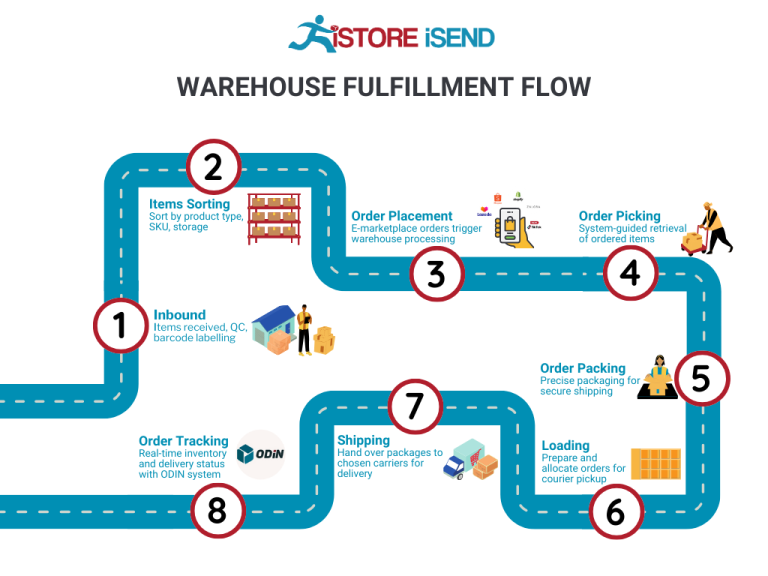
What You’ll Learn In This Guide
- What is E-commerce Fulfillment? An Introduction for Growing Businesses
- The Order Fulfillment Process: From ‘Buy’ Button to Customer’s Door
- Comparing Fulfillment Models: In-House vs. 3PL vs. Dropshipping
- A Deep Dive into Amazon FBA: Pros, Cons, and Who It’s For
- Core Services Offered by Fulfillment Centers
- How to Choose a Fulfillment Partner: A 6-Point Checklist
- Understanding Fulfillment Pricing: A Breakdown of Common Fees
- Frequently Asked Questions (FAQs) about Fulfillment
- Conclusion: Is Outsourcing Fulfillment the Right Move for Your Business?
- Important Disclaimer
The Order Fulfillment Process: From ‘Buy’ Button to Customer’s Door
1. Receiving Inventory
The first step in the order fulfillment process is receiving inventory. This phase involves the arrival of goods at the fulfillment center, where they are checked against purchase orders to ensure that the correct items and quantities have been delivered.
Importance: Proper receiving is crucial as it sets the foundation for the entire fulfillment process. Errors at this stage can lead to stock discrepancies, which can cause delays in order processing and affect customer satisfaction.
Key Term: SKU (Stock Keeping Unit) – Each item received is assigned a unique SKU, which helps in tracking inventory levels, sales data, and reordering. Efficient management of SKUs allows businesses to maintain an accurate inventory system, reducing the chances of stockouts or overstock situations.
2. Warehouse Storage
Once the inventory is received and checked, the next step is warehouse storage. This involves organizing and storing the products in designated areas within the fulfillment center. Proper categorization and arrangement are vital for efficient retrieval during the picking process.
Importance: Effective storage solutions optimize space and facilitate faster order processing. A well-organized warehouse minimizes the time employees spend searching for products, thereby improving overall operational efficiency.
Key Term: Bin Locations – Each product is assigned a specific bin location within the warehouse. This systematic placement ensures that items can be quickly found and picked when orders are received, streamlining the fulfillment process.
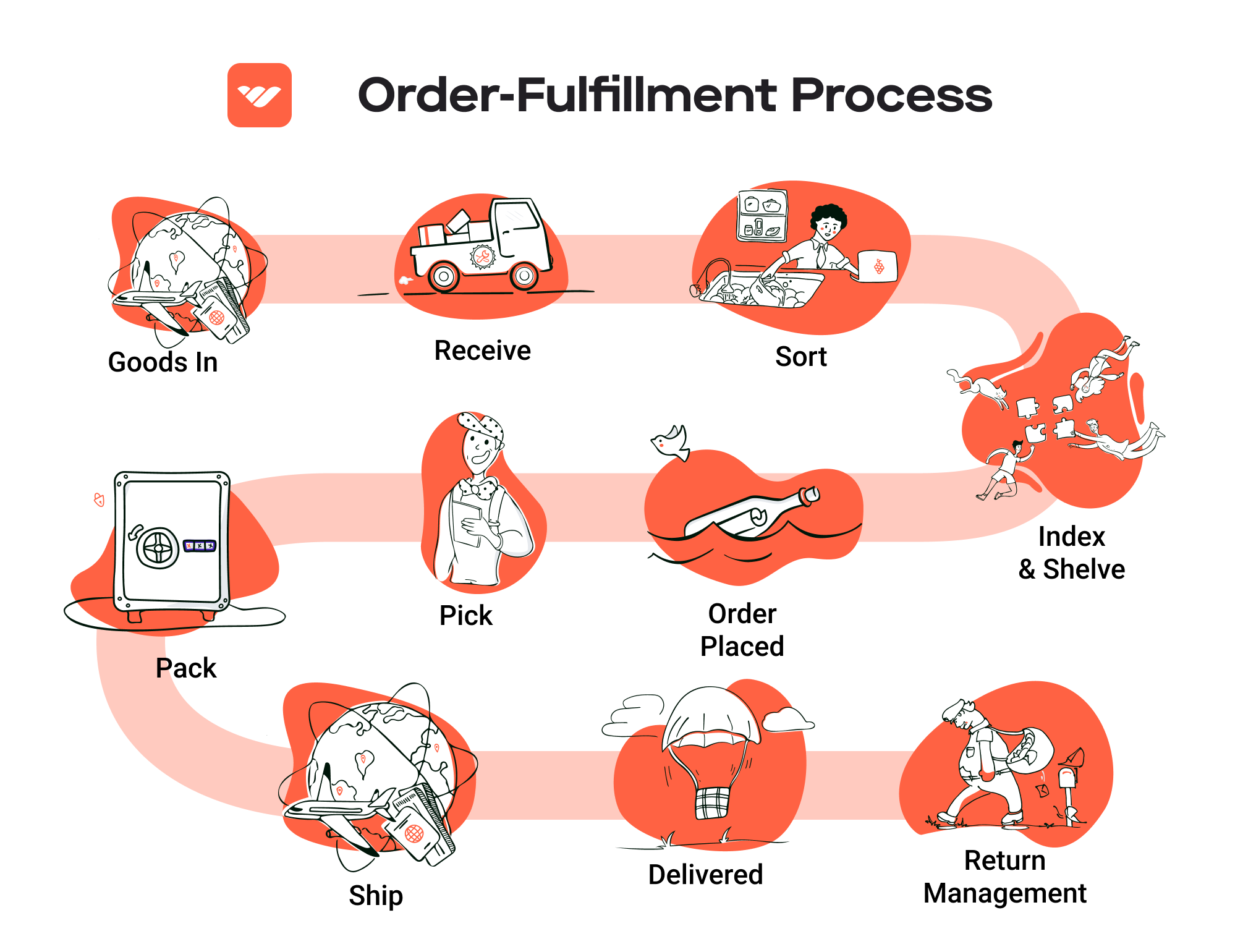
3. Order Picking
Order picking is the process of retrieving items from their storage locations based on customer orders. Employees use pick lists or digital order management systems to identify which products need to be collected and from where.
Importance: Efficient picking is essential for timely order fulfillment. Delays in this step can lead to longer lead times, which can frustrate customers and impact repeat business.
Key Term: Pick Lists – These lists detail the items to be collected, including their respective SKUs and bin locations. Utilizing pick lists helps reduce errors and ensures that the correct items are gathered in a timely manner, enhancing accuracy and speed.
4. Order Packing
After items are picked, they move to the order packing stage. Here, products are carefully packed into boxes or containers, ensuring that they are protected during transit. Packing involves selecting appropriate packaging materials and labeling the shipment for delivery.
Importance: This step is vital for ensuring that products arrive safely and intact at the customer’s doorstep. Proper packing reduces the risk of damage during shipping, which can lead to costly returns and customer dissatisfaction.
Key Term: Packing Slip – This document accompanies the shipment and includes details about the order, such as the items included, quantities, and shipping information. It serves as a reference for both the seller and the customer, facilitating easier returns and exchanges if necessary.
5. Shipping & Delivery
The final step in the order fulfillment process is shipping and delivery. Once orders are packed, they are dispatched to carriers for transportation to the customer’s address. This step includes selecting the appropriate shipping method and ensuring timely delivery.
Importance: Shipping is often the most visible part of the fulfillment process for customers. Timely and reliable delivery can significantly enhance customer satisfaction and loyalty. Conversely, delays or issues during shipping can harm the brand’s reputation.
Key Term: Shipping Carriers – These are the companies responsible for transporting goods to customers, such as FedEx, UPS, or DHL. Choosing the right carrier is crucial for optimizing shipping costs and ensuring that delivery times meet customer expectations.
Conclusion
Understanding and optimizing each step of the order fulfillment process is essential for e-commerce businesses looking to scale operations effectively. By focusing on receiving inventory, warehouse storage, order picking, packing, and shipping, companies can enhance efficiency, reduce errors, and ultimately provide a better customer experience. Investing in technology and best practices in these areas can lead to significant improvements in operational performance and customer satisfaction.
Comparing Fulfillment Models: In-House vs. 3PL vs. Dropshipping
Fulfillment Model Comparison
| Model | Who Handles Inventory | Best For (Business Stage) | Key Advantage | Key Disadvantage |
|---|---|---|---|---|
| In-House Fulfillment | The business itself | Established businesses | Complete control over inventory and processes | High overhead costs and resource-intensive |
| Third-Party Logistics (3PL) | Third-party provider | Startups to scaling businesses | Scalability and expertise in logistics | Less control over inventory and potential communication issues |
| Dropshipping | Supplier | Startups and small businesses | Low upfront investment and minimal risk | Lower profit margins and reliance on supplier reliability |
In-House Fulfillment
In-house fulfillment refers to managing the entire logistics process internally, including storage, picking, packing, and shipping. This model is often adopted by established businesses that have the resources and infrastructure to handle logistics operations. One of the primary advantages of in-house fulfillment is the complete control it provides over inventory management and order processing. Businesses can customize their packing and shipping processes to align with their brand image, ensuring a consistent customer experience. However, this model comes with significant drawbacks, including high overhead costs related to warehousing, staffing, and technology. Additionally, in-house fulfillment can be resource-intensive, requiring a dedicated team to manage logistics operations effectively. For businesses aiming for rapid growth or those with fluctuating order volumes, in-house fulfillment may not be the most efficient solution.
Third-Party Logistics (3PL)
Third-party logistics (3PL) providers, such as JW Fulfillment, offer a comprehensive suite of logistics services, including warehousing, order management, and distribution. This model is particularly advantageous for startups and scaling businesses that require flexibility and expertise in logistics without the commitment of managing these functions internally. By outsourcing fulfillment to a 3PL, businesses can leverage the provider’s established infrastructure, technology, and industry knowledge, allowing them to focus on core business operations such as marketing and product development. 3PLs often provide scalability, making it easier to manage seasonal spikes in demand or expand into new markets. However, one of the main disadvantages of using a 3PL is the potential loss of control over inventory and fulfillment processes. Communication issues can arise, particularly if the 3PL is not aligned with the business’s operational goals, leading to potential delays and customer dissatisfaction.
Dropshipping
Dropshipping is a fulfillment model where the retailer does not hold inventory but instead partners with suppliers who ship products directly to customers. This model is particularly appealing to startups and small businesses with limited capital, as it requires a low upfront investment and minimizes the financial risk associated with holding inventory. Entrepreneurs can offer a wide range of products without the burden of managing stock levels, making it an attractive option for those looking to test new markets or product lines. However, dropshipping also comes with significant challenges, including lower profit margins due to reliance on suppliers and potential issues with product quality and shipping times. Retailers must ensure they partner with reliable suppliers to maintain customer satisfaction. Additionally, since the retailer has no control over the fulfillment process, any issues that arise can lead to negative impacts on the brand’s reputation.
In summary, each fulfillment model has its unique set of advantages and disadvantages, making it essential for e-commerce businesses to evaluate their specific needs, resources, and growth strategies when deciding on the most suitable fulfillment approach.
A Deep Dive into Amazon FBA: Pros, Cons, and Who It’s For
Understanding Fulfillment by Amazon (FBA)
Fulfillment by Amazon (FBA) is a service provided by Amazon that allows sellers to store their products in Amazon’s fulfillment centers. Amazon takes care of storage, packaging, and shipping, while also handling customer service and returns for these products. This service is particularly beneficial for e-commerce businesses looking to scale quickly without the overhead of managing logistics themselves.
How FBA Works
-
Product Setup: Sellers create product listings on Amazon and choose FBA as their fulfillment method. They can either create new listings or convert existing ones to FBA.
-
Shipping Inventory: Sellers ship their products to Amazon’s designated fulfillment centers. Amazon uses advanced algorithms to determine the best warehouses for sellers’ inventory based on demand and shipping efficiency.
-
Storage and Management: Once the inventory arrives, Amazon stores it in their fulfillment centers. They manage the inventory, tracking stock levels and notifying sellers when restocking is necessary.
-
Order Processing: When a customer places an order, Amazon picks, packs, and ships the product directly to the customer. This process typically leverages Amazon’s vast logistics network, ensuring fast delivery.
-
Customer Service: Amazon handles all customer inquiries, returns, and refunds, allowing sellers to focus on other aspects of their business.
-
Multi-Channel Fulfillment: Sellers can use FBA to fulfill orders from other sales channels like their own websites or other e-commerce platforms, not just Amazon.
Pros of FBA
-
Prime Eligibility: Products fulfilled through FBA are automatically eligible for Amazon Prime, which can significantly increase visibility and sales. Prime members often prefer products that offer fast, free shipping.
-
Customer Trust: Products sold through FBA benefit from Amazon’s trusted brand reputation. Customers are more likely to purchase items fulfilled by Amazon due to the assurance of reliable shipping and customer service.
-
Multi-Channel Fulfillment: FBA allows sellers to fulfill orders from various platforms (like eBay, Walmart, etc.), streamlining logistics and inventory management.
-
Scalability: As businesses grow, FBA allows for easy scaling without the need to invest in warehousing and logistics. Sellers can focus on product development and marketing while Amazon handles fulfillment.
-
Access to Advanced Logistics: Amazon’s sophisticated logistics network ensures faster shipping times, which can lead to higher customer satisfaction and repeat purchases.
Cons of FBA
-
High Fees: FBA incurs various fees, including storage fees for inventory stored in Amazon’s warehouses and fulfillment fees for each order shipped. These costs can eat into profit margins, especially for low-cost items.
-
Strict Inventory Rules: Amazon has stringent inventory management guidelines. Sellers must adhere to these rules, which can include limits on the amount of inventory stored in fulfillment centers, potentially leading to stockouts during peak seasons.
-
Commingling Risks: When products are commingled, sellers’ inventory can be mixed with that of other sellers. This can lead to issues with returns, as customers may return a different seller’s product, causing complications for the original seller.
-
Loss of Control: By utilizing FBA, sellers relinquish some control over shipping and customer service, which can impact brand experience. Any issues in Amazon’s fulfillment process may reflect poorly on the seller.
-
Complex Fee Structure: Understanding the fee structure can be complex, with different fees for storage, fulfillment, and other services. This can make it challenging to accurately calculate profitability.
Who is FBA Best For?
Fulfillment by Amazon is particularly advantageous for:
-
Small to Medium-Sized Businesses: Companies looking to scale quickly without investing in their own logistics and warehousing infrastructure can benefit significantly from FBA.
-
E-commerce Startups: New e-commerce businesses that want to leverage Amazon’s vast customer base and logistics capabilities can find FBA a valuable tool for growth.
-
Sellers with High Volume Products: Businesses that have products with a steady sales volume can benefit from FBA’s efficient shipping and handling, maximizing profitability.
-
Brands Seeking Brand Trust: Sellers looking to establish credibility and trust with customers can leverage Amazon’s reputation and customer service through FBA.
-
Multi-Channel Sellers: Businesses that sell across various platforms and want a streamlined fulfillment process can utilize FBA to manage logistics for all sales channels from a single point.
In conclusion, Fulfillment by Amazon offers a powerful opportunity for e-commerce businesses to leverage Amazon’s logistics and customer service capabilities. While there are costs and risks associated with this service, the benefits of increased visibility, customer trust, and the ability to scale quickly often outweigh the drawbacks for many sellers. Businesses should carefully consider their product types, sales volume, and overall strategy when deciding if FBA is the right fit for them.
Core Services Offered by Fulfillment Centers
Inventory Management & Warehousing
Inventory management and warehousing are foundational services provided by fulfillment centers, allowing e-commerce businesses to effectively store and manage their products. This service typically involves systematic tracking of inventory levels, order processing, and the storage of goods in a secure and organized manner.
Fulfillment centers utilize advanced Warehouse Management Systems (WMS) to monitor stock levels in real-time, ensuring that businesses can maintain optimal inventory levels. This reduces the risk of overstocking or stockouts, which can lead to lost sales or increased holding costs. By outsourcing inventory management to a fulfillment center, e-commerce businesses can focus on core operations, such as marketing and product development, while benefiting from the expertise of logistics professionals.
The benefits of effective inventory management and warehousing include:
- Cost Efficiency: By optimizing storage space and inventory turnover, businesses can reduce warehousing costs.
- Improved Cash Flow: Efficient inventory management helps in freeing up capital tied in unsold stock, allowing businesses to reinvest in growth.
- Enhanced Customer Satisfaction: Quick and accurate order fulfillment leads to improved customer experiences, fostering loyalty and repeat purchases.
Pick and Pack Services
Pick and pack services are essential for e-commerce fulfillment, involving the selection (picking) of products from inventory and preparing them for shipment (packing). This process is critical for ensuring that orders are fulfilled accurately and efficiently.
Fulfillment centers employ systematic methods to streamline the pick and pack process, often utilizing technology such as barcode scanning and automated picking systems. This not only speeds up the fulfillment process but also minimizes errors, ensuring that customers receive the correct items.
The key benefits of utilizing pick and pack services include:
- Speed and Efficiency: Automation and optimized workflows enable faster order processing, crucial for meeting customer expectations in today’s fast-paced e-commerce environment.
- Accuracy: Advanced technologies help reduce picking errors, which can enhance customer satisfaction and reduce return rates.
- Scalability: As an e-commerce business grows, fulfillment centers can easily scale operations to handle increased order volumes without the need for significant capital investment in infrastructure.
Kitting and Assembly
Kitting and assembly services involve grouping individual items into ready-to-ship sets or preparing products for sale by assembling various components. This service is particularly beneficial for businesses that offer bundled products or require assembly before shipping.
Fulfillment centers can manage the entire kitting process, from sourcing components to assembling and packaging the final product. This not only saves time but also ensures that products are shipped correctly and in a timely manner.
The advantages of kitting and assembly services include:
- Enhanced Product Offerings: Businesses can create unique bundles or kits that differentiate them from competitors, potentially increasing sales.
- Reduced Operational Complexity: By outsourcing kitting and assembly, e-commerce businesses can simplify their operations, allowing them to focus on marketing and customer engagement.
- Improved Shipping Efficiency: Bundled products often reduce shipping costs per item, enhancing profitability.
Returns Management (Reverse Logistics)
Returns management, or reverse logistics, is a crucial service offered by fulfillment centers, especially in the e-commerce landscape where return rates can be high. This process involves handling returned products efficiently and effectively, ensuring that they are processed, restocked, or disposed of as necessary.
Fulfillment centers implement streamlined returns processes, utilizing technology to track returns and manage inventory accordingly. This not only minimizes the operational burden on e-commerce businesses but also ensures that customers have a hassle-free return experience.
The benefits of effective returns management include:
- Customer Retention: A smooth return process can enhance customer satisfaction, leading to increased loyalty and repeat business.
- Cost Reduction: Efficient processing of returns minimizes the costs associated with handling and restocking products, ultimately improving profit margins.
- Data Insights: Analyzing return data can provide valuable insights into product performance and customer preferences, informing future business decisions.
In summary, fulfillment centers offer a range of core services that are vital for the success of e-commerce businesses. By leveraging these services, entrepreneurs can enhance operational efficiency, improve customer satisfaction, and ultimately scale their businesses effectively in a competitive market.
How to Choose a Fulfillment Partner: A 6-Point Checklist
Location & Warehouse Network
Why It Matters:
The geographical location of your fulfillment partner’s warehouses directly impacts shipping times and costs. A strategically located warehouse network can facilitate faster deliveries to your customers, enhance your market reach, and reduce shipping expenses.
Questions to Ask:
– Where are your warehouses located, and how does that align with my target market?
– Do you have a network of warehouses that can help me reach my customers efficiently?
– How do you handle shipping logistics for international orders?
Technology & Integrations
Why It Matters:
In today’s e-commerce landscape, robust technology and seamless integrations with your existing systems (like your e-commerce platform, inventory management, and accounting software) are crucial. A fulfillment partner with advanced technology can offer real-time tracking, automated order processing, and data-driven insights that enhance your operational efficiency.
Questions to Ask:
– What fulfillment management system do you use, and how does it integrate with platforms like Shopify, Amazon, or eBay?
– Can you provide real-time tracking and reporting features?
– How do you handle inventory management, and what tools do you provide for visibility?
Specializations (e.g., Cold Storage, Oversized Items)
Why It Matters:
Different businesses have unique product requirements. If you deal with perishable goods, oversized items, or specific categories like consumer electronics, your fulfillment partner must have the necessary capabilities to handle these products safely and efficiently.
Questions to Ask:
– What types of products do you specialize in, and do you have experience with my specific category?
– Do you offer specialized services, such as cold storage or handling of oversized items?
– How do you ensure compliance with industry regulations for my product type?
Scalability & Capacity
Why It Matters:
As your business grows, your fulfillment needs will evolve. A partner that can scale with you—whether through increased warehouse space, staff, or technology—ensures that you can meet customer demand without disruption.
Questions to Ask:
– How do you accommodate seasonal fluctuations in order volume?
– What is your capacity for scaling operations as my business grows?
– Can you provide examples of how you have supported other clients through periods of rapid growth?
Pricing and Contracts
Why It Matters:
Understanding the pricing structure and contract terms of your fulfillment partner is essential to maintain your budget and manage cash flow. Look for transparency in pricing and flexibility in contracts to avoid unexpected costs.
Questions to Ask:
– What is your pricing model (e.g., per order, monthly fees, storage costs)?
– Are there any hidden fees I should be aware of (e.g., for returns processing, packaging, or storage)?
– What are the terms of your contracts, and is there flexibility for renegotiation as my needs change?
Customer Support & Reviews
Why It Matters:
Reliable customer support can make or break your partnership. You need a fulfillment partner who is responsive and provides excellent service, as issues can arise at any time. Additionally, reviews and testimonials from other clients can provide insight into the partner’s reliability and quality of service.
Questions to Ask:
– What support options do you offer (e.g., phone, email, chat), and what are your response times?
– Can you provide references from current or past clients?
– How do you handle issues or complaints, and what is your process for resolution?
Conclusion
Choosing the right fulfillment partner is a critical decision that can significantly impact your e-commerce operations. By using this checklist, you can systematically evaluate potential partners against your specific needs and requirements. Ensuring that your fulfillment partner aligns with your business goals will not only streamline your logistics but also enhance your customer experience, ultimately driving growth and success in your e-commerce venture.
Understanding Fulfillment Pricing: A Breakdown of Common Fees
Initial Setup Fees
Initial setup fees are one-time costs associated with onboarding your business with a fulfillment provider. This may include costs for account setup, integration with your e-commerce platforms, and any necessary training for your team on how to use the provider’s systems. The fees can vary based on the complexity of your operations and the specific requirements of the fulfillment center.
For instance, if your business requires custom software integration or specialized training, you might incur higher fees. Conversely, businesses with straightforward setups may face lower initial costs. It’s important to clarify these fees upfront and understand what is included to avoid unexpected expenses later.
Receiving Fees
Receiving fees are charged for the process of accepting and inspecting incoming inventory. This cost typically includes unloading products from trucks, checking items against shipping manifests, and storing them in the warehouse.
Calculating receiving fees often depends on the volume of goods received and the complexity of the receiving process. For example, if your shipment consists of numerous items or requires special handling (like fragile items), the receiving fees may be higher. This fee can also be charged per pallet or per item, so it’s essential to discuss your shipment sizes and frequency with your fulfillment provider to get a precise estimate.
Storage Fees (per pallet/bin)
Storage fees are recurring charges for keeping your inventory in the fulfillment center. These fees are usually calculated on a per pallet or per bin basis and can vary significantly based on location, the type of goods stored, and the overall volume of your inventory.
Most providers charge monthly storage fees, which can fluctuate based on the season. For example, during peak seasons, like holidays, storage costs may increase due to higher demand for warehouse space. To manage storage costs effectively, consider strategies such as inventory turnover management and optimizing your product offerings to avoid excess storage fees.
Pick & Pack Fees (per item/order)
Pick and pack fees cover the process of selecting items from storage (picking) and preparing them for shipment (packing). This fee can be charged per item or per order, depending on the fulfillment provider’s pricing structure.
The calculation of pick and pack fees often considers the complexity of the order. For example, orders with multiple items may incur higher fees due to the additional time and labor required. Some providers also offer tiered pricing, where the cost per item decreases as order volumes increase. It’s beneficial to discuss your average order size and frequency with your provider to estimate these costs accurately.
Shipping Fees
Shipping fees encompass the costs associated with transporting your products to customers. These fees can vary based on several factors, including the shipping method (standard, expedited, etc.), the weight and dimensions of the package, and the destination.
Shipping fees are typically calculated based on carrier rates, which can fluctuate based on fuel prices and demand. Many fulfillment providers offer discounted shipping rates due to their volume, which can lead to significant savings for your business. It’s advisable to explore all available shipping options and negotiate rates with your provider to find the most cost-effective solution for your business.
Tips for Getting an Accurate Quote
-
Provide Detailed Information: When requesting quotes, be as detailed as possible about your inventory, order volumes, and specific needs. This will help providers give you the most accurate estimates.
-
Ask About All Fees: Ensure you understand all potential fees, including any that may be variable or seasonal. Request a complete breakdown of costs to avoid surprises.
-
Negotiate Terms: Don’t hesitate to negotiate fees based on your projected volumes or long-term commitments. Many providers are willing to offer discounts for established relationships.
-
Evaluate Multiple Providers: Compare quotes from several fulfillment providers to gauge the market rate and find the best fit for your business needs.
-
Inquire About Flexibility: Discuss the flexibility of fees and contracts, especially if your business experiences seasonal fluctuations or rapid growth.
By understanding these common fulfillment pricing models and following these tips, you can better navigate the complexities of fulfillment costs and make informed decisions that support the scalability of your e-commerce business.
Frequently Asked Questions (FAQs) about Fulfillment
1. What is JW Fulfillment?
JW Fulfillment is a third-party logistics (3PL) provider specializing in cross-border e-commerce logistics. Founded in 2016, it operates a network of warehouses across the United States and internationally, offering services such as warehousing, order management, customs clearance, and distribution.
2. What services does JW Fulfillment offer?
JW Fulfillment provides a comprehensive range of services, including:
– Warehousing and inventory management
– Order fulfillment and processing
– Cross-border shipping solutions
– Returns processing
– Multi-channel integrations (e.g., Amazon, eBay, Walmart)
– Custom packaging and kitting
– Real-time tracking and customer support
3. How does JW Fulfillment support cross-border e-commerce?
JW Fulfillment specializes in facilitating cross-border e-commerce by providing logistics solutions tailored for international shipping. This includes managing customs clearance, offering global shipping options, and utilizing advanced technology for tracking and inventory management, ensuring a smooth experience for sellers and buyers alike.
4. What is a 3PL?
A third-party logistics (3PL) provider is a company that offers outsourced logistics services to businesses. This can include warehousing, transportation, distribution, and order fulfillment. By leveraging a 3PL, businesses can reduce overhead costs, streamline operations, and focus on core competencies like product development and marketing.
5. What’s the difference between a warehouse and a fulfillment center?
A warehouse primarily serves as a storage space for goods, focusing on inventory management and bulk storage. In contrast, a fulfillment center is designed specifically for processing and fulfilling orders, including picking, packing, and shipping products directly to customers. Fulfillment centers often integrate advanced technology to optimize order processing speed and accuracy.
6. How much do fulfillment services cost?
Fulfillment service costs can vary widely based on several factors, including order volume, storage space requirements, and specific services needed (e.g., packaging, shipping). Typically, costs are broken down into per-order fees, monthly storage fees, and additional charges for value-added services. It’s advisable to request quotes from providers like JW Fulfillment to understand the costs specific to your business needs.
7. How can I integrate my e-commerce platform with JW Fulfillment?
JW Fulfillment offers integrations with major e-commerce platforms such as Amazon, eBay, and Walmart. Businesses can utilize their online client portal and API for seamless integration, allowing for automatic order processing, inventory updates, and tracking information. Support is available to assist with the integration process.
8. What types of products does JW Fulfillment specialize in?
JW Fulfillment caters to a wide range of product categories, including:
– Consumer electronics
– Apparel and fashion
– Home and kitchen goods
– Health and beauty products
– Large and oversized items like furniture and appliances
Their expertise in handling diverse product types, especially larger items, makes them suitable for various e-commerce businesses.
9. What support does JW Fulfillment provide for returns processing?
JW Fulfillment offers a streamlined returns processing service, allowing businesses to efficiently manage product returns. This service includes return shipping, inspection, restocking, and inventory updates, ensuring that returned products are handled swiftly and accurately to minimize losses.
10. How does JW Fulfillment ensure timely order delivery?
JW Fulfillment employs advanced logistics technology, including a robotic warehouse management system, to optimize order processing and fulfillment. Their extensive network of warehouses strategically located in key markets allows for quicker shipping times. Additionally, their commitment to real-time tracking ensures that customers are informed throughout the delivery process, enhancing overall satisfaction.
Conclusion: Is Outsourcing Fulfillment the Right Move for Your Business?
The Case for Outsourcing Fulfillment
Outsourcing fulfillment is not merely a trend; it is a strategic move that can propel your e-commerce business to new heights. By partnering with a fulfillment service like JW Fulfillment, businesses can unlock a myriad of benefits that directly contribute to efficiency and growth.
First and foremost, outsourcing saves valuable time. Managing logistics in-house can consume significant resources, diverting your attention from core business activities such as marketing and product development. A fulfillment partner specializes in logistics, enabling you to focus on scaling your operations and enhancing customer experiences.
Scalability is another critical advantage. As your business grows, so do your fulfillment needs. A robust partner can seamlessly adjust to fluctuating demand, whether during peak seasons or unexpected surges in orders. This flexibility allows you to expand your market reach without the burden of additional overhead costs associated with warehousing and staffing.
Additionally, expertise plays a pivotal role in the success of your logistics strategy. A fulfillment provider offers industry knowledge, advanced technology, and best practices that can optimize your shipping processes. They also provide insights into international logistics, returns management, and customs clearance, which are vital for businesses looking to expand globally.
However, the choice of your fulfillment partner is crucial. Not all providers are created equal. It is essential to conduct thorough research and align your business goals with the capabilities of your fulfillment partner.
As a strategic next step, take the time to audit your current shipping processes. Assess your challenges and growth objectives. This evaluation will help you determine if partnering with a fulfillment service is the right move for your business. Transitioning to a fulfillment partner can be a game-changer, enabling you to streamline operations and drive growth effectively.
Important Disclaimer
⚠️ Important Disclaimer
The information in this guide is for educational purposes. Fulfillment services, pricing, and platform features change frequently. Always conduct your own due diligence and consult with providers directly before making business decisions.
